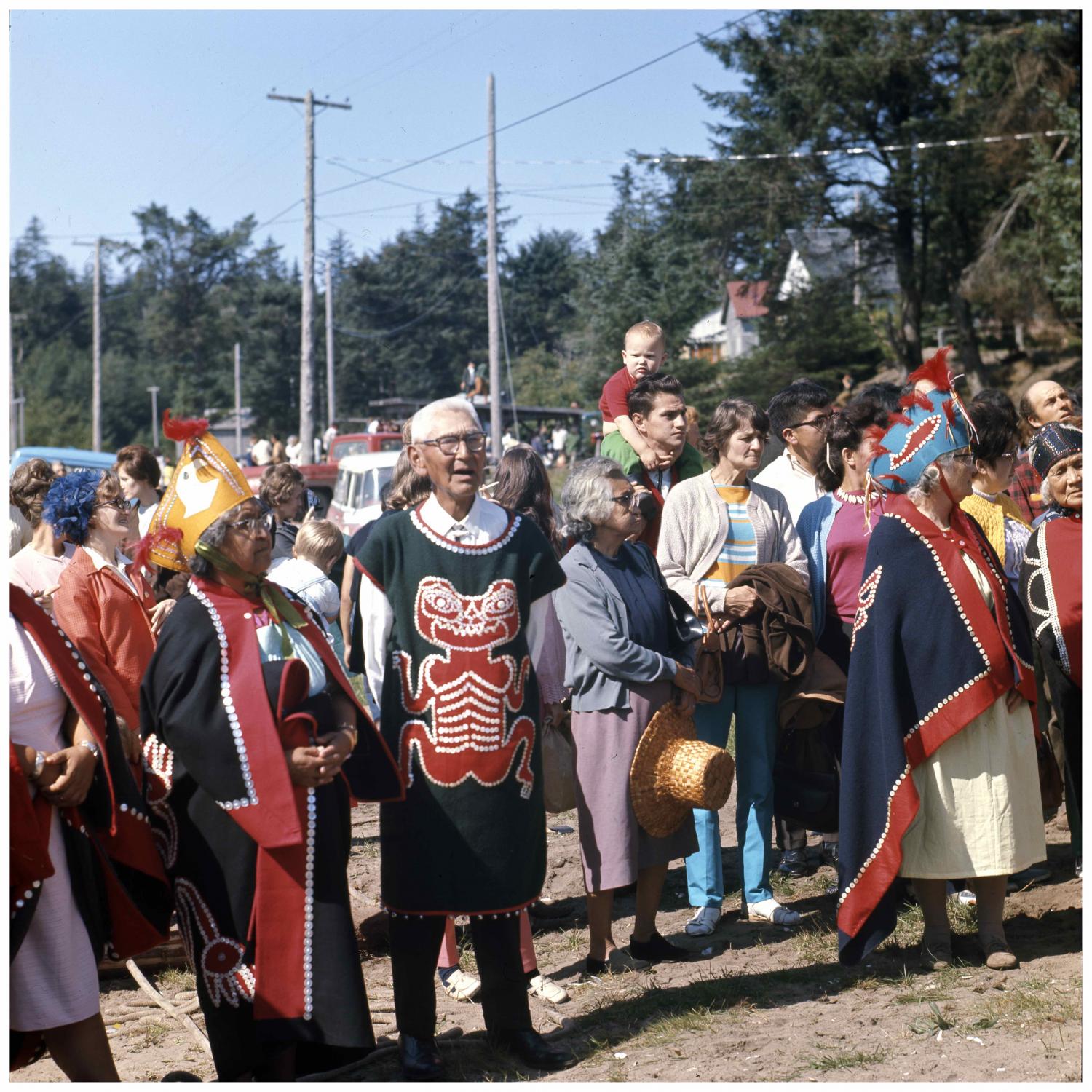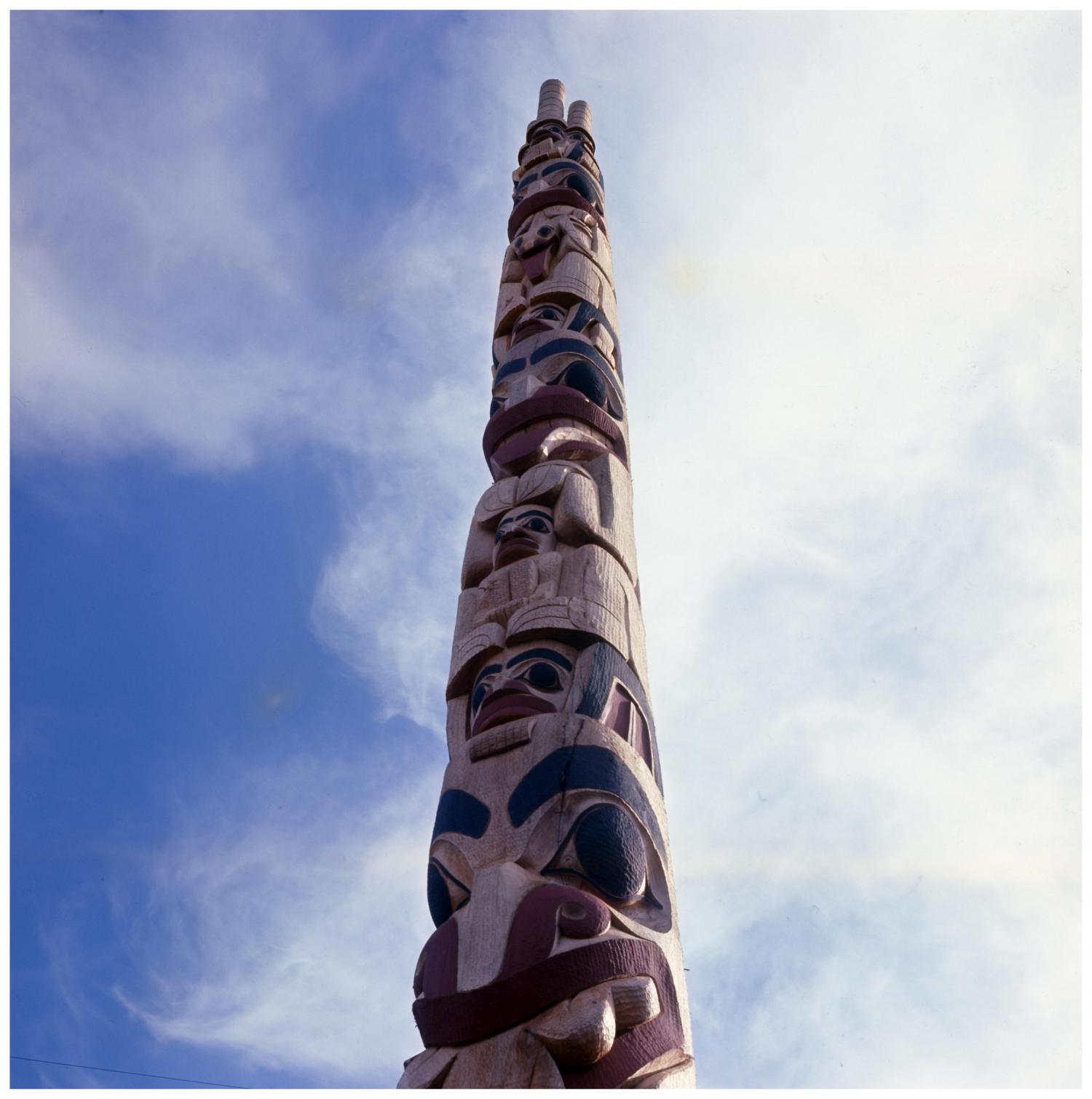Robert Davidson Raises a Pole
Twenty-two-year-old Haida artist carves first totem pole in Masset in nearly a century
Date: 1969
Robert Davidson didn’t get much of a chance to connect with his Haida roots growing up. By the time he was born in 1946, decades of persecution at the hands of the government and the church had largely erased a culture that once flourished on Haida Gwaii, which until 2009 was officially known as the Queen Charlotte Islands.
Davidson never learned how to speak Haida. He says he didn’t hear a traditional Haida song until he was 16. And many of the Nation’s totem poles — long, meticulously-carved pieces of cedar which once towered over the village of Masset, where Davidson grew up — were gone. Some had been snatched up by visiting anthropologists for display in museums halfway around the world. Others were chopped down and torched at the encouragement of Christian missionaries who warned Haida people that they wouldn’t go to heaven if the poles remained.
Davidson’s childhood lacked some crucial elements of Haida culture, but carving wasn’t one of them. When he was 13, his father and grandfather taught him how to carve, hoping he’d carry on the family tradition. Davidson’s great grandfather was famed Haida carver Charles Edenshaw. When Davidson moved to Vancouver to finish high school, he landed an opportunity to work with famed Haida artist and carver Bill Reid and eventually enrolled at the Vancouver School of Art, now known as the Emily Carr University of Art + Design. The lack of cultural artifacts back home didn’t truly dawn on Davidson until he saw his people’s art at museums in the city. When he returned to Masset, he went searching for remnants of Haida history. After knocking door to door, all he came by was a single bentwood box. Davidson immediately cherished the relic, keeping it next to him when he slept.
Physical signs of the past may have been lost, but Haida culture and stories remained very much alive in the minds of the Elders living in Davidson’s community. They inspired him to move beyond the miniature totem poles he had carved out of chunks of yellow cedar or argillite. At 22 years old, he was going to raise Masset’s first totem pole in nearly a century. “I sensed a feeling of sadness from the Elders,” Davidson explained. “I wanted to create a reason for them to celebrate one more time in a way they knew how.” But he wouldn’t do it alone. It was his father who found a suitable log. His younger brother Reg helped him carve. And Elders, translated by his uncle, informed him of the correct practices for such an undertaking.
On Aug. 22, 1969, a buzzing crowd congregated outside the church in Masset, many dressed in red and black button blankets, with some — due to a lack of traditional garb — wearing painted headpieces made of paper bags. Then Davidson and several other local men began hoisting up the 12 metre-long pole, named Mother Bear. Earlier, a construction crew had offered their crane to help raise the pole, but Davidson refused. Elders wanted to do it the traditional way, using only manpower and a system of ropes and smaller logs.
Not everything was done by the book though. In the past, only members from one of the village's two clans — Eagle and Raven — would raise the pole. This time, Eagle and Raven members did it together; Davidson wanted everybody involved. “The minute the pole stood up, the people started to dance and sing,” he said. The ceremony was followed by a potlatch, another important part of Haida culture that colonial authorities had criminalized for decades.
“The totem pole was actually a catalyst, to make a statement,” explained Davidson years later. “‘Hey! We’re alive, and we want to be part of this world.’” What followed was a cultural revival among coastal Indigenous communities. Many more poles have since been raised, and Davidson is now a world-renowned artist.
Sources:
1. Auchter, Christopher. Now Is the Time. National Film Board, www.youtube.com/watch?v=g_bjcwqajy4.
2. Duffek, Karen. The Present Moment: Conversations with Guud San Glans, Robert Davidson. faculty.washington.edu/kbunn/duffek2004001.PDF.
3. Family. Robert Davidson, www.robertdavidson.ca/family.
4. Gee, Dana. Short Film Celebrates Return of Totem Pole Raising in Haida Gwaii after a Century of Banishment. Kenora Daily Miner and News, 20 Dec. 2019, www.kenoraminerandnews.com/entertainment/movies/short-film-celebrates-return-of-totem-pole-raising-in-haida-gwaii-after-a-century-of-banishment/wcm/17b8d367-14bc-4f18-b356-165039f571c7/amp.
5. Guud Sans Glans: "Eagle Of The Dawn". Robert Davidson, www.robertdavidson.ca/biography.
6. Huang, Alice. Totem Poles. First Nations & Indigenous Foundations at the University of British Columbia, indigenousfoundations.arts.ubc.ca/totem_poles/.
7. Lederman, Marsha. Standing Tall: Robert Davidson at the Centre of a Rebirth in Northwest Coast Art. The Globe and Mail, 4 Jan. 2014, www.theglobeandmail.com/arts/art-and-architecture/standing-tall-robert-davidson-at-the-centre-of-a-rebirth-in-northwest-coast-art/article16186174/.
8. Lewis, Philip. A Fine Day in Masset: Christopher Auchter Revisits Crucial Moment in Haida Renaissance. National Film Board Blog, 13 Aug. 2019, blog.nfb.ca/blog/2019/08/13/christopher-auchter-illuminates-seminal-moment-in-haida-cultural-resurgence/.
9. Nair, Roshini. Totem Pole Raising 50 Years Ago Sparked 'Reawakening,' Haida Artist Says. CBC News, 25 Aug. 2019, www.cbc.ca/news/canada/british-columbia/haida-totem-pole-anniversary-1.5256754.
10. The Raising of the Totem Pole Raising in Massett in 1969. Sealaska Heritage, www.sealaskaheritage.org/node/1053.
11. Sheenan, Carol. Robert Davidson. The Canadian Encyclopedia, 25 Oct. 2010, www.thecanadianencyclopedia.ca/en/article/robert-davidson.
12. VIDEO: Doc on Historic Haida Gwaii Totem Pole-Raising Heads to TIFF. Sooke News Mirror, 10 Aug. 2019, www.sookenewsmirror.com/entertainment/documentary-on-historic-totem-pole-raising-in-haida-gwaii-heading-to-tiff/.
13. Woodend, Dorothy. In 'Haida Modern,' the Story of the First Totem Pole Raised in Over a Century. The Tyee, 2 June 2020, thetyee.ca/Culture/2020/06/02/Haid-Modern-Totem-Pole-Raised/.






